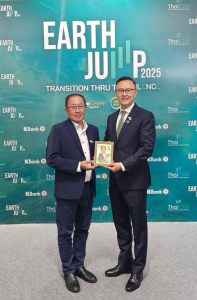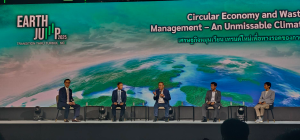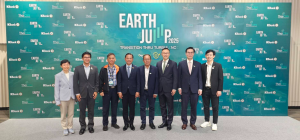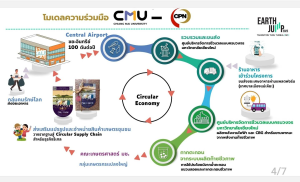From Waste to Value: CMU-CPN Collaboration Model to Create a Circular Economy, Valuing Waste for Cities, Communities, and a Sustainable Future. Presented at the “Earth Jump 2025: Transition Thru Turbulence” seminar.
Associate Professor Prasert Rerkriangkrai, Vice President of Chiang Mai University, was honored to be a speaker at the “Earth Jump 2025: Transition Thru Turbulence” seminar held at Paragon Hall, Siam Paragon Shopping Center on May 28, 2025, under the theme “Circular Economy and Waste Management – An Unmissable Climate Solution.” He presented Chiang Mai University’s concrete waste management approaches and examples of collaboration with the private sector to effectively drive the circular economy.
At the forum, Associate Professor Prasert Rerkriangkrai presented the “Waste to Energy Model” implemented by Chiang Mai University through its Integrated Biomass Management Center under the Circular Economy concept. The university has the capacity to process over 30 tons of waste per day from various sources within the university. This waste includes 11.85 tons of organic waste, 9.60 tons of RDF, 0.90 tons of glass, and various other types of waste. All of this will be processed efficiently, such as through biogas production, compost, and sludge reuse, to reduce landfills and carbon dioxide emissions.
The results of this system can generate a total value of up to 1,500–2,000 baht per ton of waste. This value is divided into biogas production (220 baht/ton), a reduction in CO₂ emissions of approximately 200 kilograms/ton, and a reduction in transportation costs of up to 1,000 baht/ton. This not only reduces the environmental burden, but also demonstrates that waste can create economic value at the university, community, and national levels.
“Circular Economy” is a key feature of the collaborative model between Chiang Mai University and Central Pattana Co., Ltd. (CPN).
This systematically integrates organic waste management from shopping centers and restaurants into new resources. The project begins by collecting over 100 tons of organic waste per year from Central Airport and restaurants in Mae Hia Municipality, which then transports it to the university’s integrated biomass management center, which can transform this waste into clean energy such as compressed biogas (CBG), electricity, and organic fertilizer. This effectively reduces landfills, carbon emissions, and waste management costs.
The products from this processing process are distributed to farmers in the Faculty of Agriculture, CMU, for use in organic farming. Value-added products are then processed and sold in CPN shopping centers, returning them to consumers. This completes the Circular Supply Chain. This model is a key example of integrated waste management, where all sectors within the system—from consumers, businesses, and academia—can truly transform waste into energy and economic, social, and environmental value.
The collaborative model between Chiang Mai University and CPN is therefore a key example of the development of a circular economy that can be applied at the community and metropolitan level, inspiring various sectors to collaborate in creating waste management systems that create shared, sustainable value for all.






